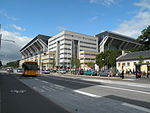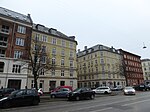Fælledparken

The park Fælledparken in Copenhagen, Denmark, was created 1906–1914 by landscape architect Edvard Glæsel in cooperation with the Copenhagen Municipality on the commons (Danish: fælled) previously named Nørrefælled and Østerfælled. Fælledparken is located in the eastern part of Copenhagen called Østerbro. Fælledparken is used for activities such as: Walking Sunbathing Running Playgrounds Soccer training and matches on the courts marked on the grass The cafe Pavillonen Copenhagen Historic Grand Prix (auto racing with old cars) 1 May: Labour Day demonstration, with speeches by politicians Concerts and celebrations such as carnivalFælledparken lies adjacent to Parken, the Danish national stadium. The southern part of Fælledparken was sometimes used by rescue helicopters from the Danish Air Force when transporting patients to Rigshospitalet. This practice was abandoned in the year 2006 with the construction of a helicopter platform on the roof of Rigshospitalet.[1] Archived 2007-03-11 at the Wayback Machine A path runs along the southern edge of Fælledparken' past the Niels Bohr Institute where Niels Bohr, Werner Heisenberg, Erwin Schrödinger and other famous physicists of the 20th century would walk and discuss their theories on space and quantum physics. These strolls in Fælledparken were essential in their thought process and theorising so soon acquired the name Filosofgangen, one of many with the same name where great thinkers gathered their thoughts.
Excerpt from the Wikipedia article Fælledparken (License: CC BY-SA 3.0, Authors, Images).Fælledparken
Trampesti, Copenhagen Østerbro
Geographical coordinates (GPS) Address Website Nearby Places Show on map
Geographical coordinates (GPS)
| Latitude | Longitude |
|---|---|
| N 55.699722222222 ° | E 12.57 ° |
Address
Sigurd Fafnersbane og slange
Trampesti
1352 Copenhagen, Østerbro
Capital Region of Denmark, Denmark
Open on Google Maps









